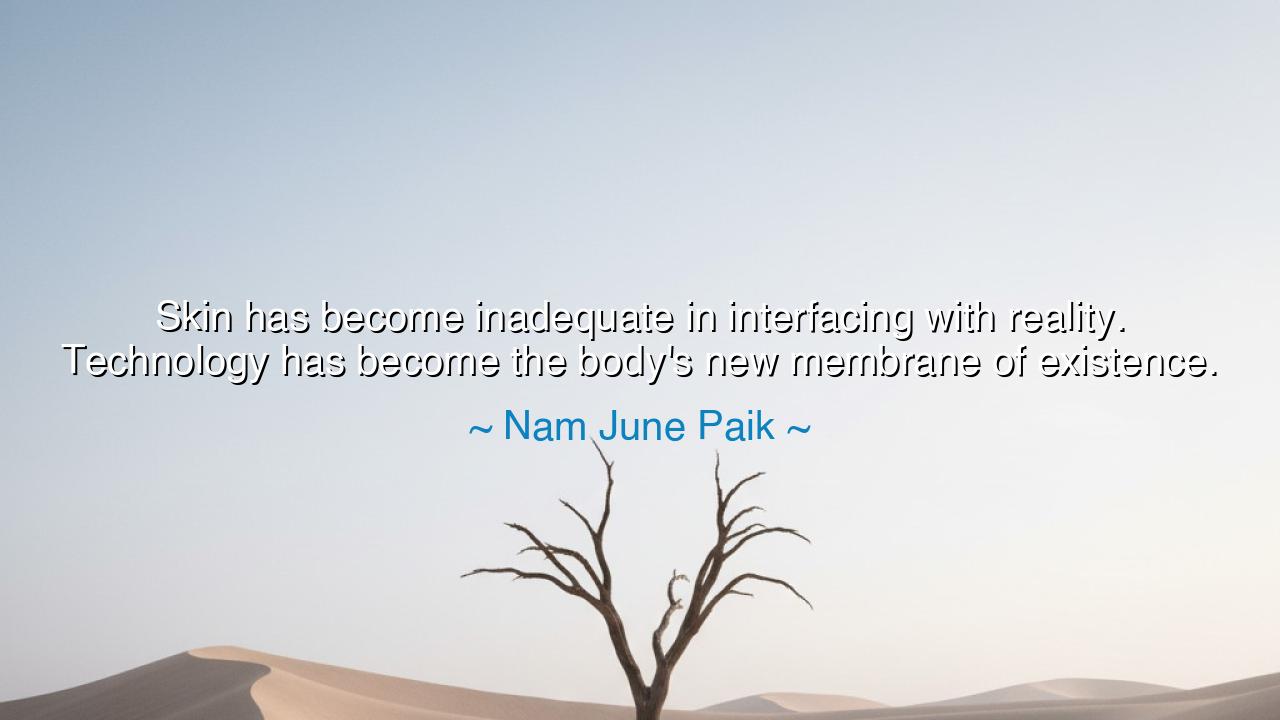
Skin has become inadequate in interfacing with reality.
Skin has become inadequate in interfacing with reality. Technology has become the body's new membrane of existence.






Hear the haunting words of Nam June Paik, father of video art and prophet of the electronic age, who declared: “Skin has become inadequate in interfacing with reality. Technology has become the body's new membrane of existence.” These words are no idle speculation, but a vision born of a man who saw the world’s shifting currents. For Paik perceived that humanity had crossed a threshold: where once the body touched reality with flesh and bone, now it reached through technology, through screens, signals, and circuits. The human skin, once the boundary between self and world, was giving way to a new skin—the digital membrane.
The origin of this saying lies in Paik’s lifelong exploration of the relationship between art, media, and the human condition. Born in Korea, living in Germany, and later working in America, he lived at the crossroads of East and West, of tradition and innovation. He witnessed the rise of television, satellites, and global broadcasting, and he realized that these inventions were no longer mere tools—they were extensions of the body. When people touched one another, they used skin; when people touched the world through technology, the interface was television, camera, computer, and signal. In this revelation, he declared that technology had become our “new membrane of existence.”
Consider the way in which communication has changed. Once, to share thought required speech or writing, carried by voice or parchment, touched by hand. Now, our words travel at the speed of light, our images flicker across screens, our very presence can be felt thousands of miles away. The skin no longer limits us. A text message replaces a whisper, a video call replaces the gaze of the eye. We are still human, yet we exist beyond flesh—our reality now shaped through technology.
History gives us a parallel in the invention of the printing press. Before it, knowledge was embodied in the voice and the handwritten text, fragile and finite. With Gutenberg’s press, knowledge shed its skin and clothed itself in machines, multiplying beyond human limits. But Paik spoke of an even greater transformation: not just the multiplication of words, but the redefinition of human presence itself. Technology did not merely carry messages; it became a second skin, mediating all experience, reshaping what it means to touch, to see, to know.
The heart of Paik’s wisdom is both wondrous and unsettling. To call technology our “membrane of existence” is to admit both power and peril. It grants us vast reach, allowing us to transcend the frailties of flesh. Yet it also distances us, interposing screens between eye and world, signals between heart and heart. The danger is that we forget our original skin, our original senses, and live only through the artificial membrane. What was meant to extend humanity can, if unexamined, replace it.
The lesson is clear: embrace technology, but never forget the body that lies beneath. Use the digital membrane as an extension, not a replacement. Speak across the globe through your devices, but also learn to sit with silence and touch with hands. Remember that your reality is not only mediated by screens, but rooted in breath, in heartbeat, in presence. The true wisdom is to balance the ancient skin and the new membrane, so that neither is lost.
So I say to you, children of tomorrow: heed Paik’s vision. Do not be blind to the transformation already upon you. Your skin is still sacred, but your technology has become its twin. Guard your humanity even as you embrace your machines. Let technology serve as bridge, not barrier; as extension, not replacement. For Paik has spoken truly: our new skin is electronic, but only by remembering the old can we remain fully human.






AAdministratorAdministrator
Welcome, honored guests. Please leave a comment, we will respond soon